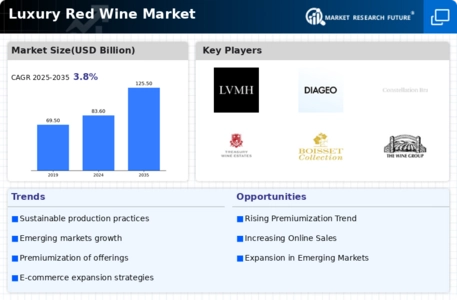Increasing Disposable Income
The luxury red wine Market appears to be positively influenced by the rising disposable income among consumers. As individuals experience an increase in their financial capacity, they tend to allocate a portion of their budget towards premium products, including luxury red wines. This trend is particularly evident in emerging markets, where economic growth has led to a burgeoning middle class with a penchant for high-quality wines. According to recent data, the luxury wine segment has seen a growth rate of approximately 5% annually, driven by affluent consumers seeking unique and exclusive offerings. The willingness to spend on luxury items, including fine wines, suggests a robust market potential for luxury red wine producers.
Evolving Consumer Preferences
Shifts in consumer preferences significantly impact the Luxury Red Wine Market. Today's consumers are increasingly discerning, favoring wines that offer unique flavor profiles and artisanal production methods. This trend is reflected in the growing demand for organic and biodynamic wines, which cater to health-conscious consumers. Additionally, the rise of wine tourism has led to a greater appreciation for regional varieties and small-batch producers. Market data indicates that premium wines, particularly those with a story or heritage, are gaining traction, with sales in this segment rising by nearly 7% over the past year. This evolution in consumer tastes presents opportunities for luxury red wine brands to innovate and differentiate themselves.
Expansion of E-commerce Platforms
The Luxury Red Wine Market is experiencing a transformative shift due to the expansion of e-commerce platforms. As consumers increasingly turn to online shopping for convenience, luxury wine retailers are adapting by enhancing their digital presence. This trend is underscored by a reported 20% increase in online wine sales over the past year, indicating a growing acceptance of purchasing luxury items online. E-commerce not only broadens the reach of luxury red wine brands but also allows for personalized shopping experiences through tailored recommendations and exclusive online offerings. The integration of technology in the purchasing process is likely to continue shaping consumer behavior, further propelling the luxury red wine market.
Growing Interest in Wine Education
An increasing interest in wine education is emerging as a notable driver for the Luxury Red Wine Market. Consumers are becoming more knowledgeable about wine, seeking to understand the nuances of different varietals, regions, and production techniques. This trend is reflected in the rise of wine tasting events, workshops, and online courses, which cater to enthusiasts eager to deepen their appreciation for luxury wines. Market data suggests that participation in wine education programs has surged by 15% in recent years, indicating a robust demand for knowledge in this sector. As consumers become more educated, their purchasing decisions are likely to be influenced by a deeper understanding of quality and craftsmanship, benefiting luxury red wine producers.
Influence of Social Media and Influencers
The Luxury Red Wine Market is increasingly shaped by the influence of social media and wine influencers. Platforms such as Instagram and TikTok have become vital channels for promoting luxury wines, allowing brands to reach a broader audience. Influencers play a crucial role in shaping consumer perceptions and preferences, often showcasing luxury red wines in aspirational contexts. Recent data indicates that brands leveraging social media marketing strategies have seen a 30% increase in engagement and sales. This trend suggests that the digital landscape is not only a marketing tool but also a significant driver of consumer interest in luxury red wines. As social media continues to evolve, its impact on the luxury wine market is likely to grow.

















